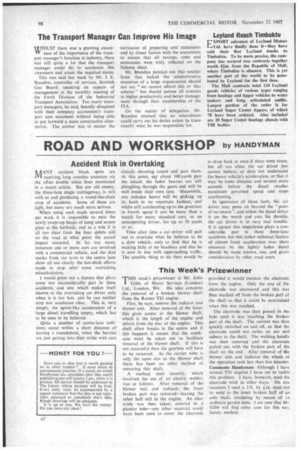ROAD AND WORKSHOP by HANDYMAN
Page 100

If you've noticed an error in this article please click here to report it so we can fix it.
Accident Risk in Overtaking
jt/TANY accident black spots are al receiving long overdue attention via the offset double white lines mentioned in a recent article. But our old enemy, the three-lane single carriageway, is still with us and producing a round-the-clock crop of accidents. Some of these are light, but many are much more serious.
-When using such roads several times per week it is impossible to miss the newly swept-up heaps of lamp and screen glass at the kerbside, and as a rule if is all too clear from the finer debris still on the road at what point the actual impact occurred. In far too many instances one or more cars are involved with a commercial vehicle, and the skid marks from car tyres in the centre lane show all too clearly the last-ditch efforts made to stop after some overtaking miscalculation.
I would point out a feature that plays some not inconsiderable part in these accidents, and one which makes itself known to the overtaking car driver only when it is too late, and he can neither stop nor accelerate clear. This is, very simply, the sprint-like acceleration of a large diesel travelling empty, which has to be seen to be believed.
Quite a number of centre-lane collisions occur within a short distance of leaving a roundabout, when the heavies are just getting into their stride with cars already shooting round and past them. At this point, say about 100 yards past the island, the laden heavies are still ploughing through the gears and will be well inside their own lane. Meanwhile, any unladen heavy will be picking up its heels in no uncertain fashion, and whilst still accelerating up to the governor in fourth speed it can be more than a match for many standard cars, or an unsuspecting driver, for up to 50 yards or so.
Time after time a car driver will pull out to overtake what he believes to be a slow vehicle, only to find that he is making little or no headway and that he is now in line with approaching traffic. The sensible thing to do then would be
to drop back at once if there were room, but all too often the car driver just cannot believe, or does not understand the heavy vehicle's acceleration, or that it may be some distance and several more seconds before the diesel reaches maximum governed speed and stops accelerating.
In ignorance of these facts, the car driver may press on beyond the "point of no return", and unless the diesel driver is on the watch and cuts his throttle. the car driver is in very real trouble. It is agreed that impatience plays a considerable part in these three-lane accidents, but this rather technical feature of almost freak acceleration over short oistances by the lightly laden diesel should be made known, too, and given consideration by other road users.
































































































































































































































































